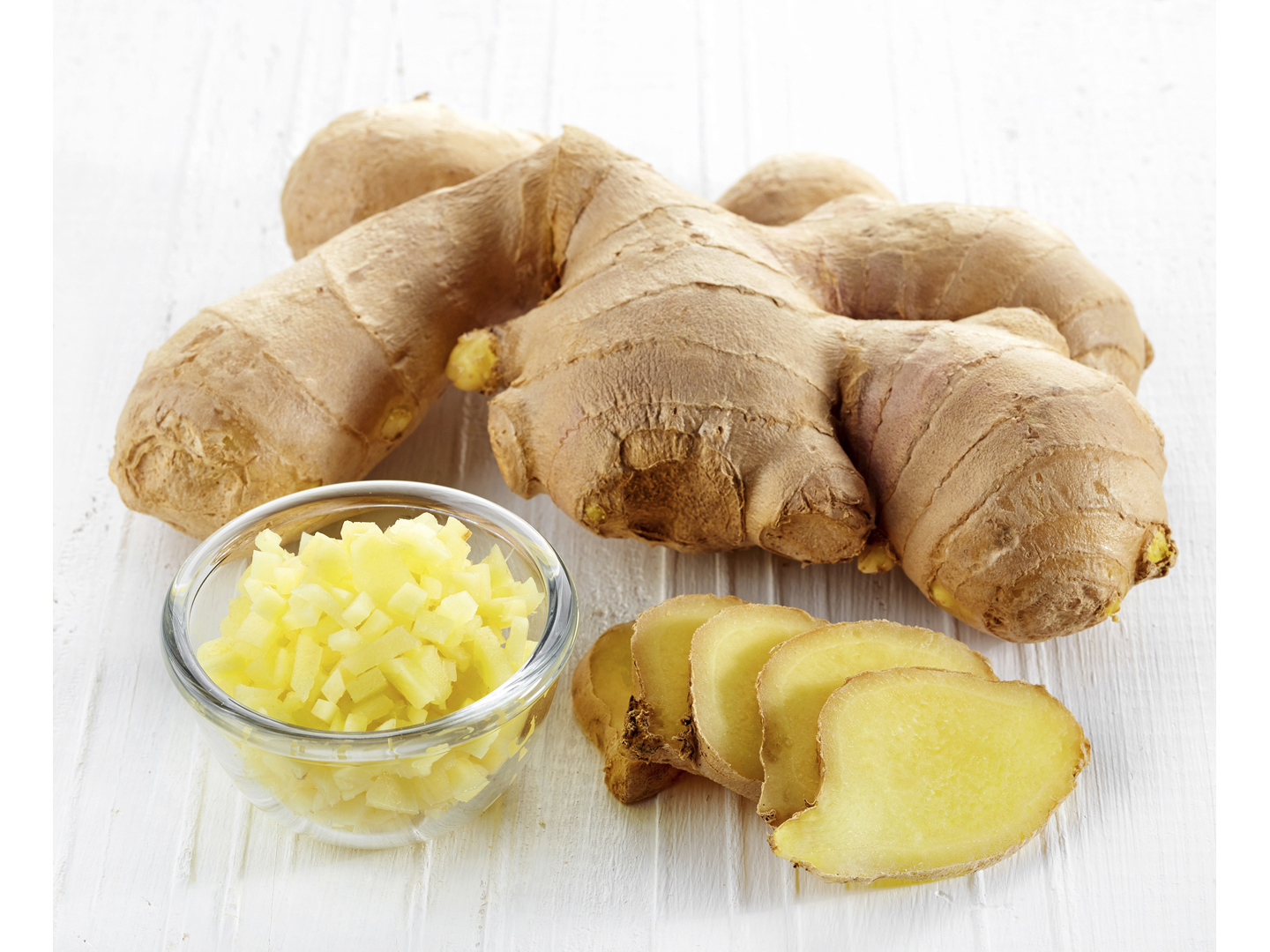I earn commissions if you shop through the links below at no additional cost to you.
Last Updated on March 23, 2023 by Jeremy
Ginger, or ginger root, native to Southeast Asia, was first mentioned in 475-221 BC during the Warring states period in China by Confucius, a Chinese philosopher, who wrote it down in his Analects.
Since then, it has been widely distributed worldwide being used in traditional cuisines as a spice as well as an ingredient in traditional medicine.
According to Wikipedia, in 2019, total global production of ginger was over 4 million Tonnes, with India being the top at 44% of world production!
Belonging to Zingiberaceae, this flowering rhizome is related to turmeric, cardamom, and galangal. With the known health benefits of turmeric, it stands to show that the health benefits of eating raw ginger is very beneficial to a body.

The Health Benefits of Eating Raw Ginger:
EASES NAUSEA
Nausea, as uncomfortable as it may be, can be eased with ingesting ginger. As per Healthline, it is mentioned that only 1-1.5 grams of ginger can greatly reduce symptoms of nausea, however, it does not have any effect on episodes of vomiting.
Morning sickness from pregnancy has been shown to decrease after eating ginger as well as those who undergo surgery, have motion sickness or seasickness (caused from the rocking of boats) or receive chemotherapy for cancers.
REDUCES INFLAMMATION AND PAIN
Ginger holds a powerful bioactive compound called gingerol, which has powerful anti-inflammatory properties that aid in reducing symptoms of inflammation, including pain.
Those who suffer from Osteoarthritis (OA), had their symptoms greatly decreased when taking 500mg-1g of ginger daily, although the taste was less to be desired.
Gingerol is also beneficial in easing menstrual cramps or pain felt during a menstrual cycle, especially if taken at the beginning of the cycle. Studies have shown that ginger can ease the symptoms better than two NSAIDS, like ibuprofen.
BOOSTS THE IMMUNE SYSTEM
Ginger contains vitamin C, or ascorbic acid, which is found in citrus and other fruits and vegetables, and is notably recognized for treating scurvy, which is a deficiency or lack of vitamin C.
It is beneficial in curbing future cold symptoms if taken in daily doses. Vitamin C distributes readily in high doses to all the cells within the immune system and is consumed quickly during infections.
Along with antimicrobial properties, vitamin C also contains natural killer cell activities as well as boosts white blood cell production.
For past colds, having tea with fresh ginger helped me and my family fight those symptoms off.
All that is needed is:
- green tea – one tea bag
- knob of ginger, peeled
- juice from half a lemon
- honey, to taste
This recipe works well in a reusable travel coffee cup. Make this tea 3-4 times a day until symptom ease.
AIDS INDIGESTION
Those who suffer from indigestion know how uncomfortable it is. One factor that is believed to cause indigestion is the delayed emptying of the stomach.
Ginger, however, has been shown to increase the emptying of the stomach, which to those who suffer regularly, is beneficial in reducing symptoms.
AIDS IN HEART HEALTH
Ginger has been shown to reduce bad cholesterol (LDL) levels as well as improve blood circulation. Together, they lower the risk of any cardiac episode in the future.
IMPROVES BRAIN FUNCTION
One cause of the destruction of the brain is oxidative stress, which is the main reason to a slew of disorders – ADHD, cancer, Parkinson’s disease, Alzheimer’s disease, heart failure, atherosclerosis, sickle-cell disease, vitiligo, and autism to name a few.
Chronic inflammation has also been shown to increase the aging process, which can affect cognitive ability and increasing the chances of brain diseases like dementia.
Ginger, containing gingerol, is the key to combating inflammation, especially if in the brain. Ingesting raw ginger can protect against age-related damage to the brain, and studies have shown to improve function in middle-aged women.
For further research, click this link: Zingiber officinale Mitigates Brain Damage and Improves Memory Impairment in Focal Cerebral Ischemic Rat – PMC (nih.gov)
MAY PREVENT CANCER
6-Gingerol is the ingredient that is linked to preventing cancer, especially in those with colorectal cancer. Consuming raw ginger holds the highest amount of 6-gingerol compared to other forms of ginger, like dried or cooked.
Gingerol is also beneficial in combating other cancers, like those of the gastrointestinal system – pancreatic cancer and liver cancer – as well as female reproductive cancers – breast cancer and ovarian cancer.
Ways to Enjoy Ginger
There are a few ways to get ginger into your daily diet, and all of them require little energy. With only needing 1-3 grams of ginger a day to ensure optimal health, it can be added without sacrificing the taste to the heat from the ginger.
RAW FORM
If the taste or the spiciness doesn’t affect you, ginger can be enjoyed raw. Whether it be chewing on fresh ginger root, or adding to your favorite smoothie recipe, ginger can be added to any recipe containing your favorite dish. The root can be peeled or washed and left unpeeled, whatever the preference.
If the taste is something to be desired, simply grate or chop the ginger and then mix it with honey to have a spicy and sweet taste that would work wonders on a sore throat as a potent lozenge.
For a spicy boost, ginger can be put through a juicer to make ‘wellness shots’ or ginger juice where another option is to put grated or thinly sliced ginger into a cup with boiling water to make tea.
According to foodhow.com, ginger tea can be made in a few simple steps as explained below:

DRIED FORM
If space seems to be the issue in maintaining ginger, then drying the rhizome might be the better solution. Not only does it give you more product, once the dried ginger is put through a processor, you have homemade ground ginger.
By making your own powdered ginger, not only does it have a longer shelf life with less degradation of vitamins and minerals, but the powder can also be used in cooking, smoothies, tea, and in supplement capsules.
To dry ginger, you will need:
- ginger
- dehydrator
Directions for drying ginger:
- wash (or peel if you want) ginger and slice thin
- layer on trays, spacing evenly to ensure even drying
- dry until all moisture is removed; dry times vary pending on slice thickness and dehydrator models
- put dried ginger in airtight container; to make ginger powder, simply put your dried ginger into a blender or food processor and pulse until it forms your desired consistency
COOKED FORM
Ginger has been used in recipes for thousands of years and will continue for many more to come.
Originating in maritime Southeast Asia, ginger has been a staple ingredient in many traditional dishes in the Philippines, Malaysia, Indonesia, and Singapore.
Since then, ginger is widely consumed globally. Many Asian dishes utilize ginger root, like the Chinese dish Ginger Beef.
In India, it is widely consumed in many dishes like curries as well as in traditional Ayurvedic medicine.
For those with a sweet tooth, ginger can be candied, adding sweetness to the spicy flavor, which you can follow along to the recipe here: How To Make Candied Ginger » The Thirsty Feast (honeyandbirch.com)
If you find that growing your own ginger is beneficial and cost effective, check out this video:
SUPPLEMENT FORM
Supplements come in all forms, from capsules to hard pills to soft gels, all benefiting the body. Ginger is no exception to the growing list of supplemental vitamins available.
Along with the multiple supplements also comes with multiple brands of product. Generic brand versus brand name products is up to the choices of consumers; check the ingredients list for any added products (like gluten or lactose) that may trigger allergies.
One such trusted brand, Jamieson, has 100 years of experience in the supplemental game, which includes raw ginger in a soft gel.
To order your Jamieson ginger supplements, click the button below:
Final Thoughts
We can all agree that ginger is a super food – with all the benefits it has, a daily dose of ginger is able to aid in healing many parts of the body.
For years, ginger has been enjoyed in many cuisines throughout the world, with many of those countries utilizing this humble rhizome in traditional medicine.
As the Western world catches up in understanding traditional medicine, more and more studies have been done on the health benefits from eating raw ginger.
As mentioned above, ginger can help heal many parts of a body like:
- easing nausea, especially associated with pregnancy, motion sickness, seasickness, surgery, and chemotherapy
- reducing inflammation and pain associated with arthritis
- boosting the immune system
- aiding indigestion
- improving heart health and brain function
- preventing some cancers of the gastrointestinal system and female reproductive system
Next time something minor ails you, like indigestion, eat some raw ginger instead of chewing those chalky Tums. It will benefit your body better with little overall effect.
If you would like to share your favorite way of enjoying ginger, feel free to leave a comment below.
Earth is Heart







Well being a farmer’s daughter, I always knew that ginger was so good for everyone. I usually only eat it when we cook it in our food, but now I might consider eating more of the raw stuff. Maybe I’ll try making ginger tea like the article says but I want to add milk on it as well. It’s really cool how a plant can be so good for your body. But have you encountered a sort of bacterial disease that’s been hitting hard on ginger crops since last year?
Adding the milk to your tea would be more reminiscent of Chai tea.
And no I haven’t heard of the bacterial disease, this information is new to me, thanks for bringing it up. I will study more into it.